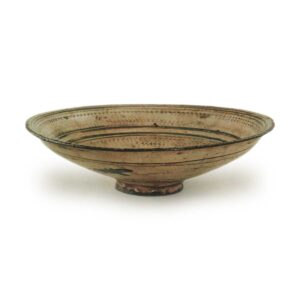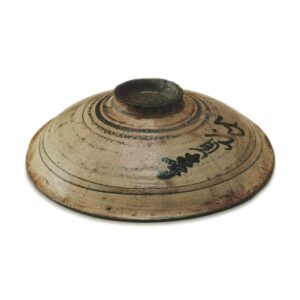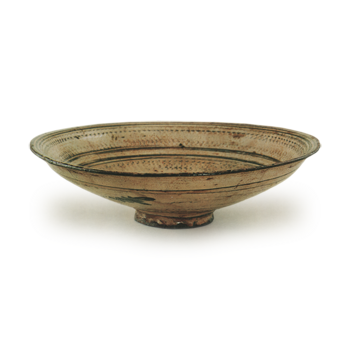

Important Cultural Property
Height: 4.8 – 5.3 cm
Diameter: 19.2 cm
Outer diameter of foot ring: 5.0 cm
Height of rim: 0.9 cm
This is a famous bowl from Mishima that was passed down in the Matsuura family of Hirado, and it is unusual in that it has the phrase “Naishiji” written on the back in black ink.
There are Mishima bowls with the names of Joseon government offices, such as Yeobin, Heunggo, Injufu, Naetongsa, and Naesajsa, and in Japan they are commonly referred to as “Yeobin Mishima”, and are considered to be particularly high-quality Mishima bowls. There are examples of white porcelain from the early Joseon period and Mishima that bear the name of the government office, or “sigo”, on them. In the 17th year of King Taejong’s reign (1417), a law was passed requiring that the name of the government office or the name of the place where the dish was made be inscribed on dishes and plates used by government offices, as a way of preventing the theft of government property, which was becoming a serious problem at the time. If they were used by the general public, it would be clear at a glance that they were stolen government property.
During the Goryeo period, the temple was called the Ministry of State Guests, the Ministry of State Guests, and the Temple of State Guests, and it was a place where foreign envoys and important ministers were entertained. In old Korean books, it is recorded that it was in charge of “entertaining state guests, ministers, and others”. It is said that Japanese envoys who visited this place brought back many of the items inscribed with the words “reihin”, and the term “reihin-mishima” (meaning “the three islands of hospitality”) originated from this place.
Naeja-sa was originally called Uiseong-go, following the system of the Goryeo period, but it was renamed Naeja-sa in the third year of King Taejong (1403). It was an office that oversaw “rice, noodles, soy sauce, honey, fruit, and weaving”, and was abolished in the 19th year of King Taejo (1882). Some items with the characters “naishi” or “naishi-ji” have come to Japan, but surviving examples are relatively rare, and I have never seen any other tea bowls with the characters “naishi-ji” written in iron-painting. This Mishima-taira tea bowl, which has been handed down in the Matsuura family, has a small, sandy footring, and is thinly made and thinly glazed. The sand is baked into the inside of the bowl, and the shape, clay, and Mishima pattern all have the characteristics of the Mishima ware from Gyeryongsan.
From the kiln site at Gyeryongsan in Chungcheongnam-do, shards of pottery with the same Mishima design and the same characters for “Naesaji” written in iron sand have been discovered, so there is no doubt that this tea bowl was made at Gyeryongsan.
The clay is a coarse soil mixed with iron-rich sand, and several lines are drawn on the inside and outside of the piece on the potter’s wheel. The Mishima pattern, as it is commonly known, is added to the entire inside and outside of the piece using a clay mold, and then white clay is inlaid and a thin, transparent white glaze is applied. The glaze is not very thick, so the glaze surface is slightly translucent, and the glaze pools have a hint of blue.
There are three gutters around the rim, and there is also a crack in the foot that is called a “mountain scar” from firing, and there are also a few small tears around the rim, which have been repaired with lacquer, but it is almost perfect. It is a simple and gentle teacup.
The kiln site of Keiryu-zan was excavated on a large scale at the beginning of the Showa period, and the excavated items were also brought to Japan. However, the Keiryu-zan that has been handed down is relatively rare, and the Ueda Rekite in the Nezu Museum and this Hira tea bowl, which has been handed down in the Matsuura family, are generally well known.
As it is a surviving piece, it has a certain subdued quality, and the areas with white inlay and white slip have turned a light brown color.
The inner box is decorated with Marushunkei lacquerware and the two characters “Reihin” are written in red, while the outer box is paulownia wood with the two characters “Shiko” written by Masuda Don’o.



